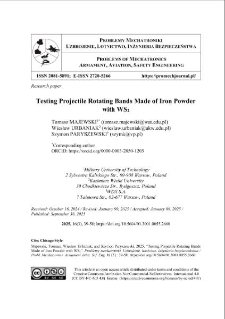Nasza Biblioteka Cyfrowa udostępnia 1 868 obiektów cyfrowych
Obiekt
Tytuł: Testing Projectile Rotating Bands Made of Iron Powder with WS2 ; Testing Projectile Rotating Bands Made of Iron Powder with WS2
Tytuł odmienny:
Badania pierścieni wiodących pocisków wytworzonych z proszku Fe z dodatkiem WS2 ; Badania pierścieni wiodących pocisków wytworzonych z proszku Fe z dodatkiem WS2
Współtwórca:
Wiesław URBANIAK , Szymon PARYSZEWSKI ; Wiesław URBANIAK , Szymon PARYSZEWSKI
Abstrakt:
This article presents the results of experiments on rotating bands manufactured from iron powder, with the addition of tungsten disulfide (WS₂). Test samples were produced using different compaction pressures and varying amounts of the WS₂ lubricant. In the initial stage of the study, properties such as porosity, density, selected mechanical characteristics, and friction coefficient were measured. These results enabled the optimisation of the rotating band manufacturing process. In the subsequent phase, rotating bands were fabricated and assembled onto projectiles. Push-through force tests were then conducted to assess the behaviour of the rotating bands under quasi-static conditions. The results demonstrated that the addition of a lubricating material lowers the friction coefficient and reduces both engraving and push-through forces.
;
This article presents the results of experiments on rotating bands manufactured from iron powder, with the addition of tungsten disulfide (WS₂). Test samples were produced using different compaction pressures and varying amounts of the WS₂ lubricant. In the initial stage of the study, properties such as porosity, density, selected mechanical characteristics, and friction coefficient were measured. These results enabled the optimisation of the rotating band manufacturing process. In the subsequent phase, rotating bands were fabricated and assembled onto projectiles. Push-through force tests were then conducted to assess the behaviour of the rotating bands under quasi-static conditions. The results demonstrated that the addition of a lubricating material lowers the friction coefficient and reduces both engraving and push-through forces.
Miejsce wydania:
Warszawa
;
Warszawa
Wydawca:
Wojskowa Akademia Techniczna ; Wojskowa Akademia Techniczna
Data utworzenia:
Data złożenia:
Data akceptacji:
Data wydania:
Rozmiar:
Identyfikator:
oai:ribes-88.man.poznan.pl:2741
Sygnatura:
10.5604/01.3001.0055.2660 ; 10.5604/01.3001.0055.2660
ISSN elektroniczny:
ISSN drukowany:
Język:
Licencja:
kliknij tutaj, żeby przejść ; kliknij tutaj, żeby przejść
Właściciel praw:
Wojskowa Akademia Techniczna ; Wojskowa Akademia Techniczna
Strona początkowa:
Strona końcowa:
Tom:
Czasopismo:
Słowa kluczowe:
rotating bands, powder metallurgy, tungsten disulfide ; rotating bands, powder metallurgy, tungsten disulfide
Kolekcje, do których przypisany jest obiekt:
Data ostatniej modyfikacji:
17 paź 2025
Data dodania obiektu:
17 paź 2025
Liczba wyświetleń treści obiektu:
0
Wszystkie dostępne wersje tego obiektu:
https://ribes-88.man.poznan.pl/publication/3082
Wyświetl opis w formacie RDF:
Wyświetl opis w formacie OAI-PMH:
| Nazwa wydania | Data |
|---|---|
| Testing Projectile Rotating Bands Made of Iron Powder with WS2 | 17 paź 2025 |
Obiekty Podobne
Tomasz MAJEWSKI Andrzej DĘBSKI, Katarzyna LESZCZYŃSKA-SEJDA
Tomasz MAJEWSKI
Tomasz MAJEWSKI Marcin SARZYŃSKI, Judyta SIENKIEWICZ, Jerzy SZAWŁOWSKI, Tomasz BABUL, Sylwester JOŃCZYK
Tomasz MAJEWSKI Waldemar A. TRZCIŃSKI, Leszek SZYMAŃCZYK

